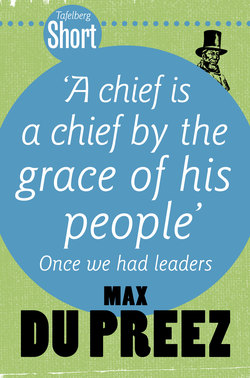Читать книгу Tafelberg Short: A chief is a chief by the grace of his people - Max du Preez - Страница 5
На сайте Литреса книга снята с продажи.
ОглавлениеA savage prince and a formidable adversary
In our search for indigenous leadership models, we could look at leaders like Chief Maqoma (1798-1873), the right-hand son of Ngqika, king of the Rharhabe division of the Xhosa people.
Maqoma was, by all oral and written accounts, a man of special intellect, insight, bravery and charisma; a leader, a diplomat and a guerrilla tactician who fought in all ways available to him to save his people from the ravages of colonialism. And yet the colonial authorities and some missionaries made him out to be a hopeless drunk, a charge that was clearly untrue.
Noël Mostert says this about Maqoma in his formidable tome on Xhosa history, Frontiers: ‘Of all the Xhosa chiefs who stood in the arena as the Xhosa nation entered this central and decisive period of its confrontation with the Cape Colony and the British army, Maqoma alone was seen by all as indisputably the greatest leader, the potential organiser of Xhosa military power, and the likeliest indigenous victor, if there was to be one.’[2]
The British military officer Colonel Richard Collins said Maqoma was ‘a noble specimen of a savage prince, capable of being moulded into a Christian hero’.[3] But Chief Maqoma was harassed and frustrated by ruthless British colonial governors and military men his whole adult life and eventually crushed, with Sir George Grey especially seeing it as his mission to destroy Maqoma. He could therefore never actualise his full potential as a leader and statesman.
The chief was tried in a farcical court on trumped-up charges and was sentenced to twenty years’ hard labour on Robben Island, arriving there in December 1857. After he was released in 1869, he went farming, but when the colonial government realised that he was never going to be its puppet and that his mere presence still meant something to the Xhosa people, he was sent back to the island. He died there on 9 September 1873. On 13 August 1978 his remains were taken to the eastern Cape and reburied in the Heroes’ Acre on top of the Amatolas with some 15 000 people in attendance.
We could also consider King Sekhukhune (1814-1882) of the Bapedi as a worthy role model. He fought valiantly against a two-pronged assault on his people’s independence by the British and the Boers of the Transvaal Republic. He refused to be Christianised and expelled the white missionaries from his kingdom, vowing to protect the spiritual and cultural integrity of what was then called the Marota kingdom between the Vaal and Limpopo Rivers.
Sekhukhune’s army repelled four huge attacks from the Boers and the British between 1876 and 1879, but he was eventually captured after a major force of British and Swazi troops defeated his warriors. He was jailed in Pretoria, but assassinated by his half-brother Mampuru after his release in 1882.
Unusually, the London Times of 30 August 1882 wrote an almost glowing obituary of the ‘formidable’ Sekhukhune. ‘We hear this morning from Durban of the death of one of the bravest of our former enemies, the Chief Sekhukhune . . . The news carries us some years back to the time when the name of Sekhukhune was a name of dread, first to the Dutch and then to the English Colonists of the Transvaal and Natal.’
As with Maqoma, we don’t know how Sekhukhune would have developed further as a leader if the colonial powers hadn’t quashed him.
2. Noël Mostert: Frontiers – The Epic of South Africa’s Creation and the Tragedy of the Xhosa People (London: Jonathan Cape, 1992), p 613
3. Mostert, p 369
